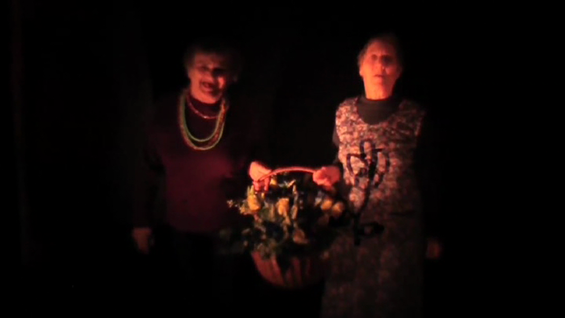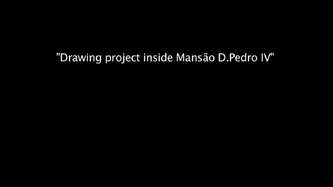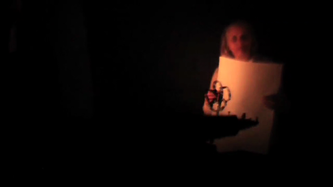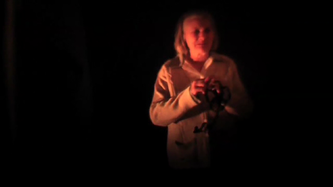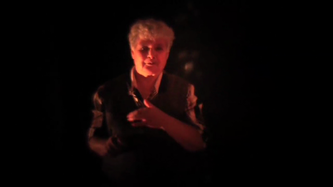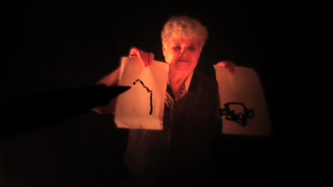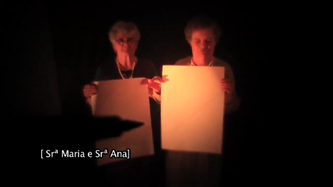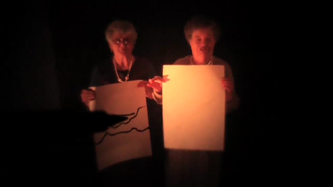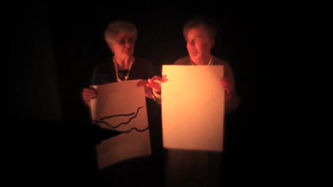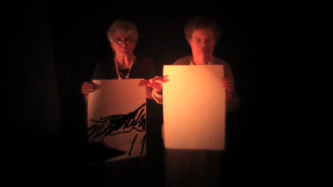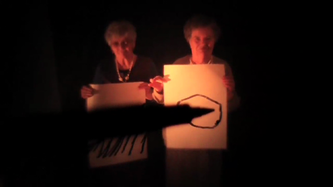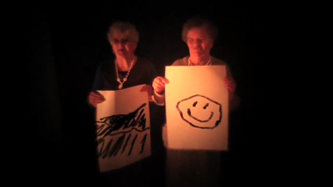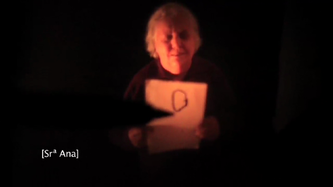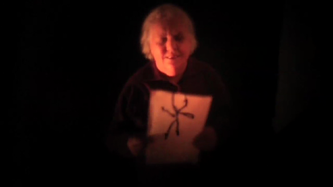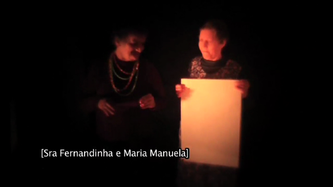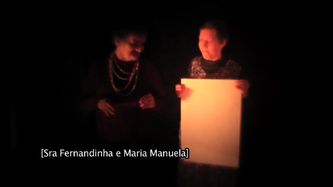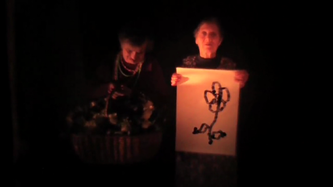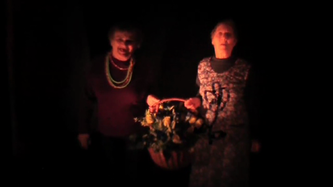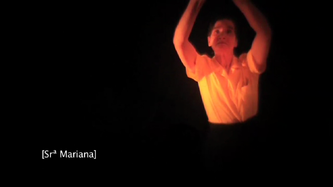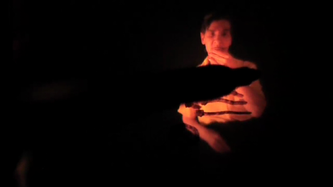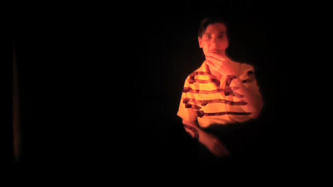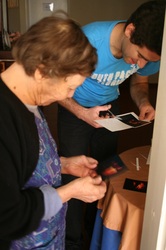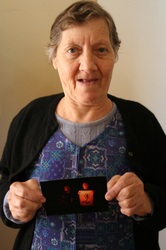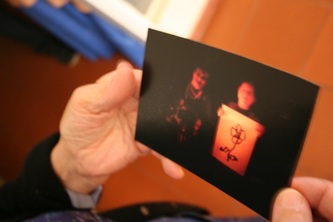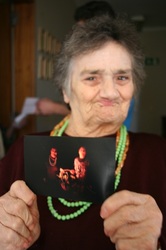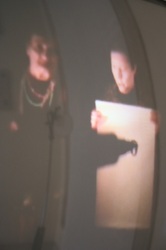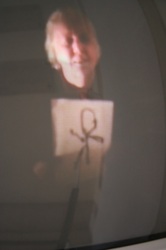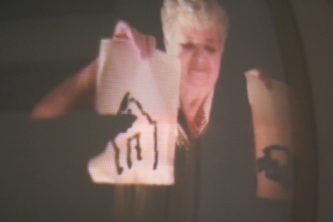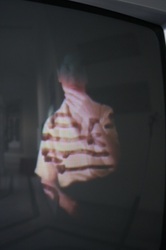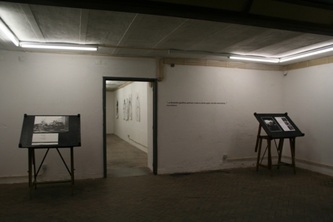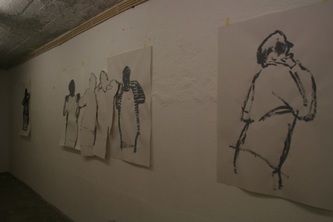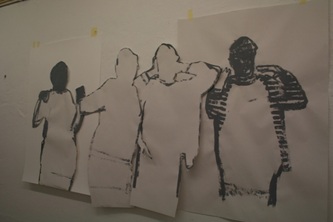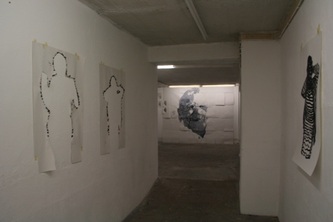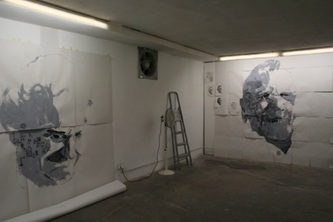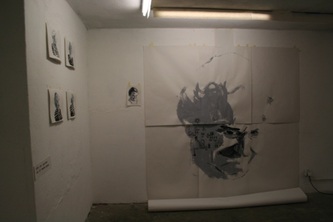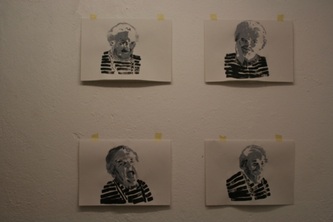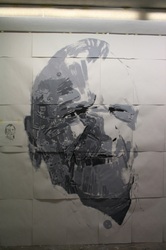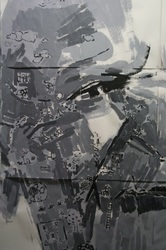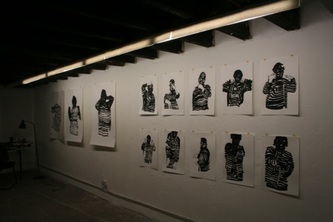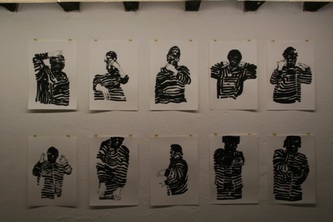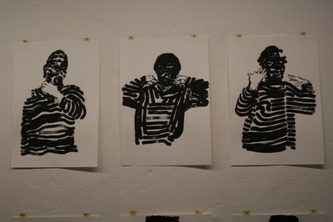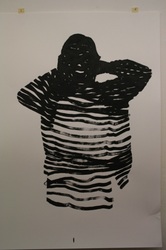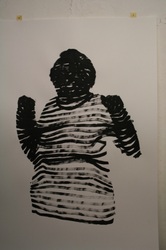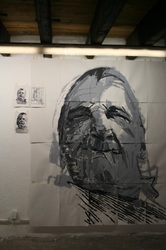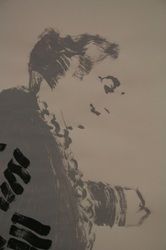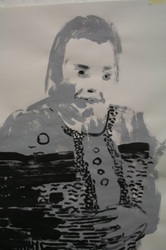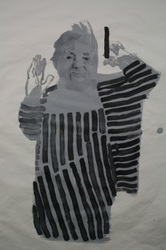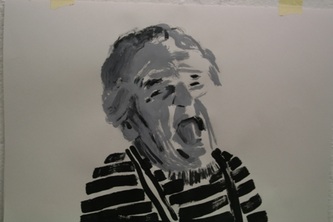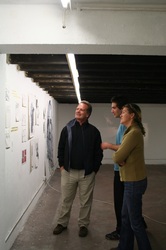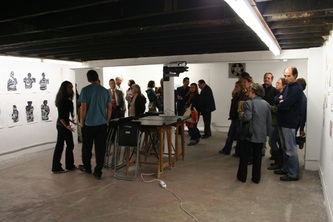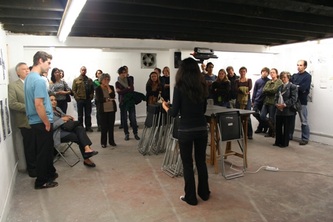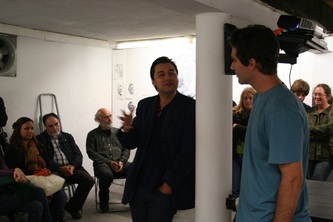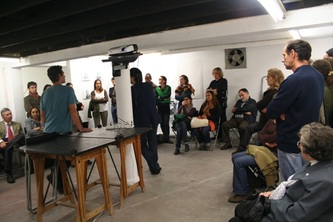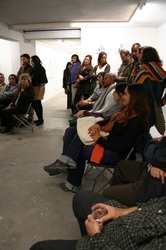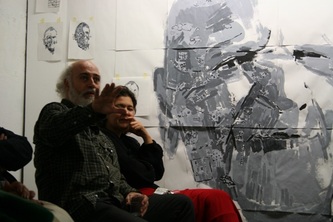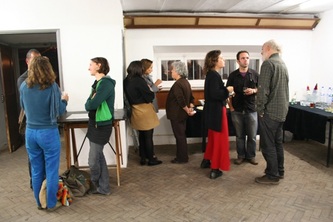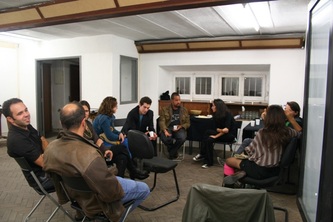_© All rigths reserved to Associação Espaços do
Desenho-Drawing Spaces. Text.Sound.Video.Images
_
THE DRAWING GOT LEGS...
Drawing inside and outside the camera and with other devices
Mansão D. Pedro IV (Home Care Centre), Marvila
and Drawing Spaces, Fábrica Braço de Prata
Lisbon, Portugal
3 – 23 OCTOBER 2010
Drawing inside and outside the camera and with other devices
Mansão D. Pedro IV (Home Care Centre), Marvila
and Drawing Spaces, Fábrica Braço de Prata
Lisbon, Portugal
3 – 23 OCTOBER 2010
REPORT 5 - IDEAL
Intercultural Drawing for European Adult Learning
Intercultural Drawing for European Adult Learning
WHAT
WHERE
Mansão D. Pedro IV (Home Care Centre) and Drawing Spaces, Fábrica Braço de Prata, Marvila, Lisbon, Portugal
WHEN
WHO
facilitators and staff
Joa Gridfonte
Teresa Carneiro
(respondants to the project)
José Carlos Pereira (School of Fine Arts, University of Lisbon)
Nuno Nabais (Philosopher, Director of Fábrica Braço de Prata)
ADULT LEARNERS
12 male and female senior residents from Mansão D. Pedro IV (Home Care Centre), Marvila, Lisbon, Portugal.
why
Mansão D. Pedro IV is a Home Care Centre with hospital facilities dedicated to elder people and adults with physical and mental impairments. Mansão D. Pedro IV is situated in Marvila, a socially and economically deprived area, where Drawing Spaces /Fábrica Braço de Prata is also located. At the beginning of 2010 Drawing Spaces approached Mansão D. Pedro IV with a proposal to develop a continuing set of activities as part of the IDEAL – GRUNDTVIG project. The proposal was well accepted and since then, Drawing Spaces has been periodically organizing and developing a series of activities for the senior community of Mansão D. Pedro IV, which have included, among its participants, some of the residents with physical and mental impairments.
The drawing got legs… was a residency project which took place at Drawing Spaces during October 2010, under the responsibility of the artist Joa Gridfonte. In this residency the artist proposed to explore several drawing related projects developed in interaction with senior residents from Mansão D. Pedro IV – a Home Care Centre situated in neighbourhoods of Drawing Spaces. This project based itself in the construction of portraits from residents at Mansão D. Pedro IV, while the parameters for the portraits –for example, its sets and poses – were (re)invented, (re)negotiated and (re)created with the artist in its interaction with the participants, within the conditions of possibility of the participants and their exchanges with the artist.
According to Joa Gridfonte, the artist in residency: “[The drawing got legs…] was part of a research project on the materiality of drawing, looking into ways of giving evidence in drawing of a sense of touch, and making it more tangible while creating new readings upon reality. More roughly, it aimed to explore and develop human characteristics, both physical and psychological, within drawing, so that drawing could integrate our reality with a kind of form and personality of its own.” Joa Gridfonte
HOW
(cont.) “[During the project, there were some] informal castings - 'Casting to explore someone's potential to become a good drawing' – with some of the senior residents from Mansão de Santa Maria de Marvila (..) The casting itself was a process for creating new drawing languages with the participants. A couple of selected 'actors' then participated in the development of a number of independent drawing languages resulting from the interactions with each of them. [Please see the video attached to this report]All proposals were developed between the space of residency at Drawing Spaces, Fabrica do Braço de Prata, and various spaces at Mansão de Santa Maria de Marvila, including interiors, exteriors and surrounding areas.The drawings were defined by the strategic approach to the ideas [from the artist] and interactions [with the participants] and this resulted onto various shapes which were materialized through different working tools and materials. The final results integrated drawing, photography, sculpture, installation, video and performance.
[To provide an example, throughout this project, Joa Gridfonte] used "tools" of his own preference such as an adapted Polaroid camera, a 35mm camera adapted to be used in a medium format and a video camera that allowed him to draw inside the film in real time, making real-time animation, etc...” Joa Gridfonte
Along with his various experiences with the photographic and video cameras, Joa Gridfonte developed several ‘portrait’ drawings on paper from the participants, under several scales, in an interplay between negative and positive, and based on the more theatrical approaches from the video and photographic projects, The painted portraits were also based on the conversations that the artist undertook with the participants throughout the project. The issue of posing for a portrait, be it in video, or for drawing or painting, acquired a very ambiguous status in this project. The fact that the participants being portrait were elder people with limited movements and no ambition whatsoever to look like people in magazines, famous portrait paintings or similar to people on TV or in movies, questioned the entire significance and rules for posing for portraits. As such, any rule for looking ‘right’ or being in the ‘right pose’ became suspended throughout this interaction, while participants were left free to pose in whatever way they desired, in from of the camera or of the artist who was drawing. The space for creating the portraits was then essential to the project, as it was equally created by participants and artists. (Please see photographs of the exhibition attached to this report).
VALUE FOR PARTICIPANTS
Participants were empowered with the task of creating the project with the artist. Through conversations, interactions among the participants and artist, decisions were made which determined the ways in which this project would develop. Therefore, participants were fully conscious of the huge role which had been given to them in terms of their active participation in the creation of the several works that resulted from the project.
Participants felt very much confident in being asked to ‘act’ for the camera, while understanding quite well that part of the outcome was beyond their control. They seemed to enjoy that play between knowing and not knowing and allowing themselves to enjoy the process. Participants felt extremely happy and overwhelmed by the results, it seemed that they had help discover the best way to produce a ‘real’, rather than posed, portrait of themselves. Participants also engaged extremely well with facilitators, in terms of being willing to ‘act’ in front of the camera, of negotiation ways of posing for the drawings and paintings, and also in terms of talking and telling their own stories, some of which were graphically registered in the large scale portraits.
VALUE FOR FACILITATORS
Working with elder people was an extremely rich experience for facilitators, particularly in this project. The expectancies of the participants over the results of what a portrait could be were totally different from the normalized expectation of photographic portraits, video portraits, drawing portraits, painting portraits. This was extremely surprising and rich for the facilitators as it made it much easier and fluid in terms of having the participants collaborating on the creative process, rather than just waiting for instructions in terms of ‘what to do’ and ‘how to act.’ This also allowed for the project to become very experimental and opened, which undoubtedly fulfilled much more than the project aims. Participants were extremely giving in this project which made it a huge learning experience for the facilitators – the opportunity for the participants to express themselves was just enough for them deliver themselves fully to the project. Working with people outside the parameters of what might be expected socially or culturally was something extremely enriching for the artist and the facilitators. Facilitators understood that the creativeness and quality of results would had worked differently if these particular participants had not been chosen for the project.
VISUAL RECORDS
- An artist residency by Joa Gridfonte with several drawing related projects developed in interaction with residents from Mansão D. Pedro IV – a Home Care Centre situated in the neighbourhoods of Drawing Spaces. According to the artist, The drawing got legs... ‘aimed to explore and develop human characteristics, both physical and psychological, within drawing, so that drawing could integrate our reality with a kind of form and personality of its own.’
- An exhibition of the works resultant from the residency
- An opening and formal discussion of the project
WHERE
Mansão D. Pedro IV (Home Care Centre) and Drawing Spaces, Fábrica Braço de Prata, Marvila, Lisbon, Portugal
WHEN
- development of the project at Mansão D. Pedro IV: 3 – 23 October 2010, 15.00 – 19.00h
- Open residency at Drawing Spaces: 13 – 23 October, 19.00 – 23.00h
- Exhibition Opening /Project presentation and discussion: 23 October 21.30h
WHO
facilitators and staff
Joa Gridfonte
Teresa Carneiro
(respondants to the project)
José Carlos Pereira (School of Fine Arts, University of Lisbon)
Nuno Nabais (Philosopher, Director of Fábrica Braço de Prata)
ADULT LEARNERS
12 male and female senior residents from Mansão D. Pedro IV (Home Care Centre), Marvila, Lisbon, Portugal.
why
Mansão D. Pedro IV is a Home Care Centre with hospital facilities dedicated to elder people and adults with physical and mental impairments. Mansão D. Pedro IV is situated in Marvila, a socially and economically deprived area, where Drawing Spaces /Fábrica Braço de Prata is also located. At the beginning of 2010 Drawing Spaces approached Mansão D. Pedro IV with a proposal to develop a continuing set of activities as part of the IDEAL – GRUNDTVIG project. The proposal was well accepted and since then, Drawing Spaces has been periodically organizing and developing a series of activities for the senior community of Mansão D. Pedro IV, which have included, among its participants, some of the residents with physical and mental impairments.
The drawing got legs… was a residency project which took place at Drawing Spaces during October 2010, under the responsibility of the artist Joa Gridfonte. In this residency the artist proposed to explore several drawing related projects developed in interaction with senior residents from Mansão D. Pedro IV – a Home Care Centre situated in neighbourhoods of Drawing Spaces. This project based itself in the construction of portraits from residents at Mansão D. Pedro IV, while the parameters for the portraits –for example, its sets and poses – were (re)invented, (re)negotiated and (re)created with the artist in its interaction with the participants, within the conditions of possibility of the participants and their exchanges with the artist.
According to Joa Gridfonte, the artist in residency: “[The drawing got legs…] was part of a research project on the materiality of drawing, looking into ways of giving evidence in drawing of a sense of touch, and making it more tangible while creating new readings upon reality. More roughly, it aimed to explore and develop human characteristics, both physical and psychological, within drawing, so that drawing could integrate our reality with a kind of form and personality of its own.” Joa Gridfonte
HOW
(cont.) “[During the project, there were some] informal castings - 'Casting to explore someone's potential to become a good drawing' – with some of the senior residents from Mansão de Santa Maria de Marvila (..) The casting itself was a process for creating new drawing languages with the participants. A couple of selected 'actors' then participated in the development of a number of independent drawing languages resulting from the interactions with each of them. [Please see the video attached to this report]All proposals were developed between the space of residency at Drawing Spaces, Fabrica do Braço de Prata, and various spaces at Mansão de Santa Maria de Marvila, including interiors, exteriors and surrounding areas.The drawings were defined by the strategic approach to the ideas [from the artist] and interactions [with the participants] and this resulted onto various shapes which were materialized through different working tools and materials. The final results integrated drawing, photography, sculpture, installation, video and performance.
[To provide an example, throughout this project, Joa Gridfonte] used "tools" of his own preference such as an adapted Polaroid camera, a 35mm camera adapted to be used in a medium format and a video camera that allowed him to draw inside the film in real time, making real-time animation, etc...” Joa Gridfonte
Along with his various experiences with the photographic and video cameras, Joa Gridfonte developed several ‘portrait’ drawings on paper from the participants, under several scales, in an interplay between negative and positive, and based on the more theatrical approaches from the video and photographic projects, The painted portraits were also based on the conversations that the artist undertook with the participants throughout the project. The issue of posing for a portrait, be it in video, or for drawing or painting, acquired a very ambiguous status in this project. The fact that the participants being portrait were elder people with limited movements and no ambition whatsoever to look like people in magazines, famous portrait paintings or similar to people on TV or in movies, questioned the entire significance and rules for posing for portraits. As such, any rule for looking ‘right’ or being in the ‘right pose’ became suspended throughout this interaction, while participants were left free to pose in whatever way they desired, in from of the camera or of the artist who was drawing. The space for creating the portraits was then essential to the project, as it was equally created by participants and artists. (Please see photographs of the exhibition attached to this report).
VALUE FOR PARTICIPANTS
Participants were empowered with the task of creating the project with the artist. Through conversations, interactions among the participants and artist, decisions were made which determined the ways in which this project would develop. Therefore, participants were fully conscious of the huge role which had been given to them in terms of their active participation in the creation of the several works that resulted from the project.
Participants felt very much confident in being asked to ‘act’ for the camera, while understanding quite well that part of the outcome was beyond their control. They seemed to enjoy that play between knowing and not knowing and allowing themselves to enjoy the process. Participants felt extremely happy and overwhelmed by the results, it seemed that they had help discover the best way to produce a ‘real’, rather than posed, portrait of themselves. Participants also engaged extremely well with facilitators, in terms of being willing to ‘act’ in front of the camera, of negotiation ways of posing for the drawings and paintings, and also in terms of talking and telling their own stories, some of which were graphically registered in the large scale portraits.
VALUE FOR FACILITATORS
Working with elder people was an extremely rich experience for facilitators, particularly in this project. The expectancies of the participants over the results of what a portrait could be were totally different from the normalized expectation of photographic portraits, video portraits, drawing portraits, painting portraits. This was extremely surprising and rich for the facilitators as it made it much easier and fluid in terms of having the participants collaborating on the creative process, rather than just waiting for instructions in terms of ‘what to do’ and ‘how to act.’ This also allowed for the project to become very experimental and opened, which undoubtedly fulfilled much more than the project aims. Participants were extremely giving in this project which made it a huge learning experience for the facilitators – the opportunity for the participants to express themselves was just enough for them deliver themselves fully to the project. Working with people outside the parameters of what might be expected socially or culturally was something extremely enriching for the artist and the facilitators. Facilitators understood that the creativeness and quality of results would had worked differently if these particular participants had not been chosen for the project.
VISUAL RECORDS
